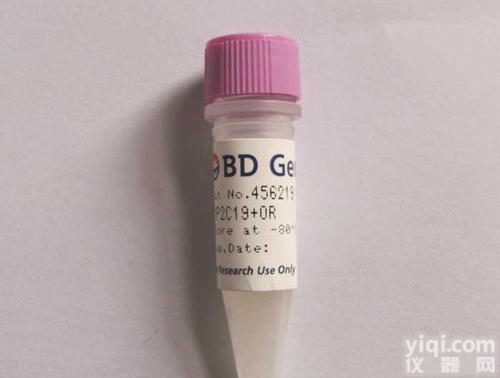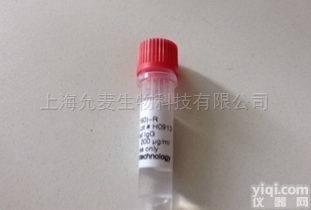产品名称:晶状体发育相关蛋白Six3抗体,Anti-Six3抗体售后服务
中文名称:晶状体发育相关蛋白Six3抗体
英文名称:Anti-Six3
产品编号:byk-11970R
产品规格:0.1ml/0.2ml
产品用途:科研实验
性 状: Lyophilized or Liquid
浓 度: 1mg/1ml
亚 型: IgG
贮 存: 贮存于-20℃.
相关标记: HRP Biotin Gold RBITC AP FITC Cy3 Cy5 Cy5.5 Cy7 PE PE-Cy3 PE-CY5 PE-CY5.5 PE-CY7 APC Alexa Fluor 350 Alexa Fluor 488 Alexa Fluor 555 Alexa Fluor 647
我公司拥有领先的细胞服务技术,先进的仪器设备和专业的ELISA检测试剂盒、生物索标记、荧光索标记、酶标记等,广泛用于多种分析研究与技术测定。欢迎来电咨询,我们将竭诚为你服务!
晶状体发育相关蛋白Six3抗体,Anti-Six3抗体售后服务 相关产品:
腺苷三磷酸结合盒转运体A1抗体 Anti-ABCA1/ABC1
泛素特异性蛋白酶OTB1抗体 Anti-OTUB1
拮抗凋亡转录因子抗体 Anti-AATF
巴尔得-别德尔综合征相关蛋白8抗体 Anti-BBS8/TTC8
AATK细胞凋亡关联酪氨酸激酶抗体 Anti-AATK
α-1抗胰蛋白酶抗体 Anti-alpha 1 Antitrypsin
TBR1蛋白抗体 Anti-TBR1
丙氨酰tRNA合成酶2抗体 Anti-AARS2
巴尔得-别德尔综合征相关蛋白10抗体 Anti-BBS10
巴尔得-别德尔综合征相关蛋白5抗体 Anti-BBS1
AP2关联激酶1抗体 Anti-AAK1
α-1抗胰糜蛋白酶抗体 Anti-AACT-Alpha1
唐氏综合征细胞粘附分子抗体 Anti-Dscam
腺苷A2A受体抗体 Anti-A2AR/Adenosine A2a receptor
8-羟基脱氧鸟苷抗体 Anti-8-OHdG/8 Hydroxyguanosine
磷酸化转录因子E2F1抗体 Anti-phospho-E2F1 (Thr433)
5-脂氧合酶抗体 Anti-5 lipoxygenase
5-羟色胺受体4抗体 Anti-5-HTR4
钠离子通道蛋白7α/Na+ CP type VIIα抗体 Anti-SCN7A
5-羟色胺受体3抗体 Anti-5-HTR3/HTR3A
抗体规律
(1)初次反应产生抗体:当抗原一次进入机体时,需经一定的潜伏期才能产生抗体,且抗体产生的量也不多,在体内维持的时间也较短。
(2)再次反应产生抗体:当相同抗原第二次进入机体后,开始时,由于原有抗体中的一部分与再次进入的抗原结合,可使原有抗体量略为降低。随后,抗体效价迅速大量增加,可比初次反应产生的多几倍到几十倍,在体内留存的时间亦较长。
(3)回忆反应产生抗体:由抗原刺激机体产生的抗体,经过一定时间后可逐渐消失。此时若再次接触抗原,可使已消失的抗体快速上升。如再次刺激机体的抗原与初次相同,则称为特异性回忆反应;若与初次反应不同,则称为非特异性回忆反应。非特异性回忆反应引起的抗体的上升是暂时性的,短时间内即很快下降。
晶状体发育相关蛋白Six3抗体,Anti-Six3抗体售后服务 产品详情:
The Six proteins (sine oculis) are a family of homeodomain transcription factors that share a conserved DNA binding domain. Six3 is required for the specification and proliferation of the eye field in vertebrates and may be involved in some developmental disorders of the brain. Expression of Six3 is detected in human embryos as early as five to seven weeks of gestation, and is maintained in the eye throughout the entire period of fetal development. At 20 weeks of gestation, expression of Six3 in the human retina has been observed in ganglion cells and in cells of the inner nuclear layer. Six3 maps to human chromosome 2p16-p21, between genetic markers D2S119 and D2S288. The map position of human Six3 overlaps the positions of two dominant disorders (holoprosencephaly type 2 and Malattia leventinese) with ocular phenotypes that have been assigned to this chromosomal region.
 晶状体发育相关蛋白Six3抗体,Anti-Six3抗体
晶状体发育相关蛋白Six3抗体,Anti-Six3抗体
 Anti-Six3抗体,晶状体发育相关蛋白Six3抗体价格
Anti-Six3抗体,晶状体发育相关蛋白Six3抗体价格
 Biotin 标记Six3抗体,晶状体发育相关蛋白Six3抗体
Biotin 标记Six3抗体,晶状体发育相关蛋白Six3抗体
 Six3抗体,晶状体发育相关蛋白Six3抗体FITC.PE
Six3抗体,晶状体发育相关蛋白Six3抗体FITC.PE
 Anti-Six3抗体 晶状体发育相关蛋白Six3抗体
Anti-Six3抗体 晶状体发育相关蛋白Six3抗体
 Anti-Six3抗体,晶状体发育相关蛋白Six3抗体
Anti-Six3抗体,晶状体发育相关蛋白Six3抗体
 Anti-Six3抗体,晶状体发育相关蛋白Six3抗体
Anti-Six3抗体,晶状体发育相关蛋白Six3抗体
 Six3抗体 晶状体发育相关蛋白Six3抗体
Six3抗体 晶状体发育相关蛋白Six3抗体
 Six3抗体 晶状体发育相关蛋白Six3抗体
Six3抗体 晶状体发育相关蛋白Six3抗体
 Anti-BFSP2抗体 Anti-BFSP2抗体,晶状体蛋白2抗体
Anti-BFSP2抗体 Anti-BFSP2抗体,晶状体蛋白2抗体
 进口/国产 BFSP2抗体,晶状体蛋白2抗体
进口/国产 BFSP2抗体,晶状体蛋白2抗体
 Anti-gamma C Crystallin抗体,晶状体球蛋白γ3/γC-crystallin/白内障相关蛋白抗体说明
Anti-gamma C Crystallin抗体,晶状体球蛋白γ3/γC-crystallin/白内障相关蛋白抗体说明